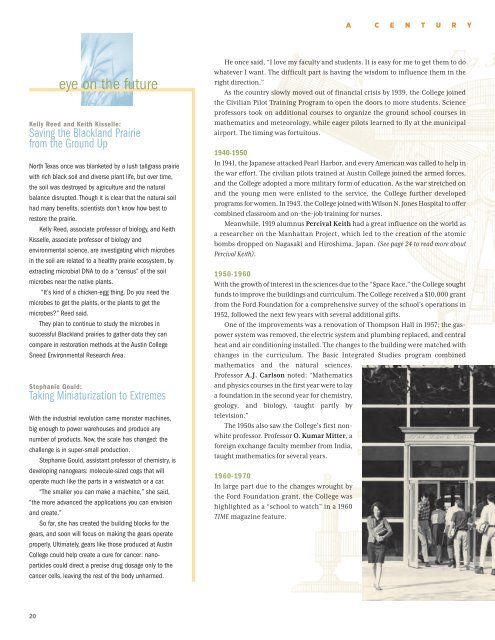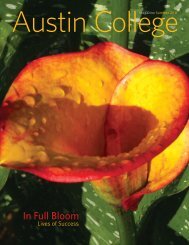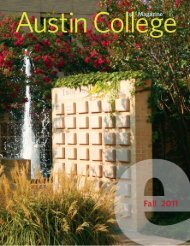Winter 2012 - Austin College Magazine
Winter 2012 - Austin College Magazine
Winter 2012 - Austin College Magazine
You also want an ePaper? Increase the reach of your titles
YUMPU automatically turns print PDFs into web optimized ePapers that Google loves.
A C E N T U R Y<br />
eye on the future<br />
Kelly Reed and Keith Kisselle:<br />
Saving the Blackland Prairie<br />
from the Ground Up<br />
North Texas once was blanketed by a lush tallgrass prairie<br />
with rich black soil and diverse plant life, but over time,<br />
the soil was destroyed by agriculture and the natural<br />
balance disrupted. Though it is clear that the natural soil<br />
had many benefits, scientists don’t know how best to<br />
restore the prairie.<br />
Kelly Reed, associate professor of biology, and Keith<br />
Kisselle, associate professor of biology and<br />
environmental science, are investigating which microbes<br />
in the soil are related to a healthy prairie ecosystem, by<br />
extracting microbial DNA to do a “census” of the soil<br />
microbes near the native plants.<br />
“It’s kind of a chicken-egg thing. Do you need the<br />
microbes to get the plants, or the plants to get the<br />
microbes?” Reed said.<br />
They plan to continue to study the microbes in<br />
successful Blackland prairies to gather data they can<br />
compare in restoration methods at the <strong>Austin</strong> <strong>College</strong><br />
Sneed Environmental Research Area.<br />
Stephanie Gould:<br />
Taking Miniaturization to Extremes<br />
With the industrial revolution came monster machines,<br />
big enough to power warehouses and produce any<br />
number of products. Now, the scale has changed: the<br />
challenge is in super-small production.<br />
Stephanie Gould, assistant professor of chemistry, is<br />
developing nanogears: molecule-sized cogs that will<br />
operate much like the parts in a wristwatch or a car.<br />
“The smaller you can make a machine,” she said,<br />
“the more advanced the applications you can envision<br />
and create.”<br />
So far, she has created the building blocks for the<br />
gears, and soon will focus on making the gears operate<br />
properly. Ultimately, gears like those produced at <strong>Austin</strong><br />
<strong>College</strong> could help create a cure for cancer: nanoparticles<br />
could direct a precise drug dosage only to the<br />
cancer cells, leaving the rest of the body unharmed.<br />
He once said, “I love my faculty and students. It is easy for me to get them to do<br />
whatever I want. The difficult part is having the wisdom to influence them in the<br />
right direction.”<br />
As the country slowly moved out of financial crisis by 1939, the <strong>College</strong> joined<br />
the Civilian Pilot Training Program to open the doors to more students. Science<br />
professors took on additional courses to organize the ground school courses in<br />
mathematics and meteorology, while eager pilots learned to fly at the municipal<br />
airport. The timing was fortuitous.<br />
1940-1950<br />
In 1941, the Japanese attacked Pearl Harbor, and every American was called to help in<br />
the war effort. The civilian pilots trained at <strong>Austin</strong> <strong>College</strong> joined the armed forces,<br />
and the <strong>College</strong> adopted a more military form of education. As the war stretched on<br />
and the young men were enlisted to the service, the <strong>College</strong> further developed<br />
programs for women. In 1943, the <strong>College</strong> joined with Wilson N. Jones Hospital to offer<br />
combined classroom and on-the-job training for nurses.<br />
Meanwhile, 1919 alumnus Percival Keith had a great influence on the world as<br />
a researcher on the Manhattan Project, which led to the creation of the atomic<br />
bombs dropped on Nagasaki and Hiroshima, Japan. (See page 24 to read more about<br />
Percival Keith).<br />
1950-1960<br />
With the growth of interest in the sciences due to the “Space Race,” the <strong>College</strong> sought<br />
funds to improve the buildings and curriculum. The <strong>College</strong> received a $10,000 grant<br />
from the Ford Foundation for a comprehensive survey of the school’s operations in<br />
1952, followed the next few years with several additional gifts.<br />
One of the improvements was a renovation of Thompson Hall in 1957; the gaspower<br />
system was removed, the electric system and plumbing replaced, and central<br />
heat and air conditioning installed. The changes to the building were matched with<br />
changes in the curriculum. The Basic Integrated Studies program combined<br />
mathematics and the natural sciences.<br />
Professor A.J. Carlson noted: “Mathematics<br />
and physics courses in the first year were to lay<br />
a foundation in the second year for chemistry,<br />
geology, and biology, taught partly by<br />
television.”<br />
The 1950s also saw the <strong>College</strong>’s first nonwhite<br />
professor. Professor O. Kumar Mitter, a<br />
foreign exchange faculty member from India,<br />
taught mathematics for several years.<br />
1960-1970<br />
In large part due to the changes wrought by<br />
the Ford Foundation grant, the <strong>College</strong> was<br />
highlighted as a “school to watch” in a 1960<br />
TIME magazine feature.<br />
20 | <strong>Austin</strong> <strong>College</strong> <strong>Magazine</strong> <strong>Winter</strong> <strong>2012</strong>





